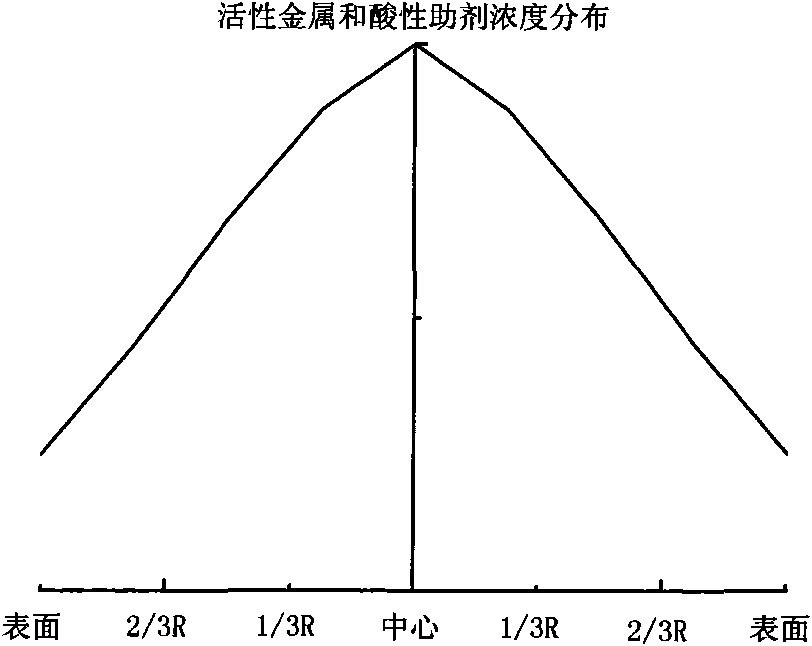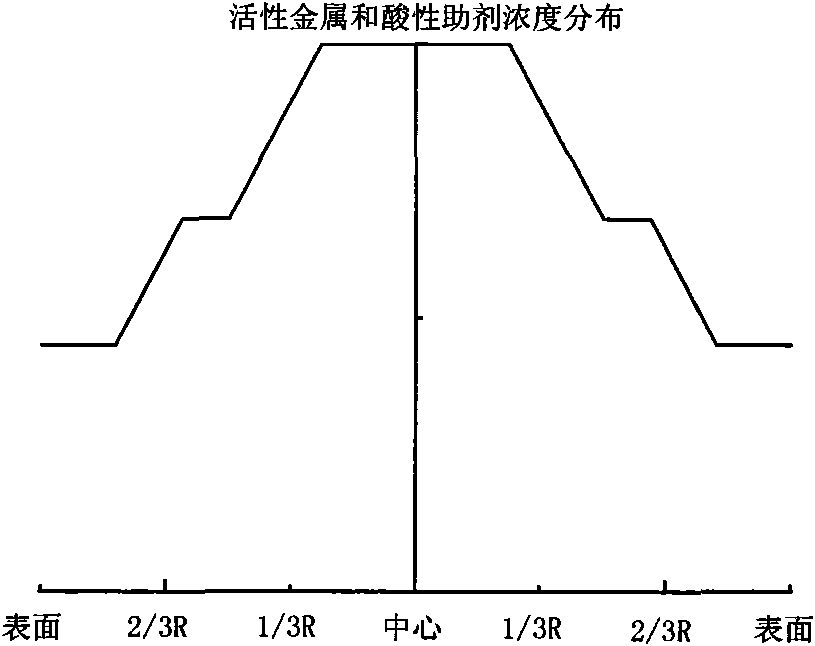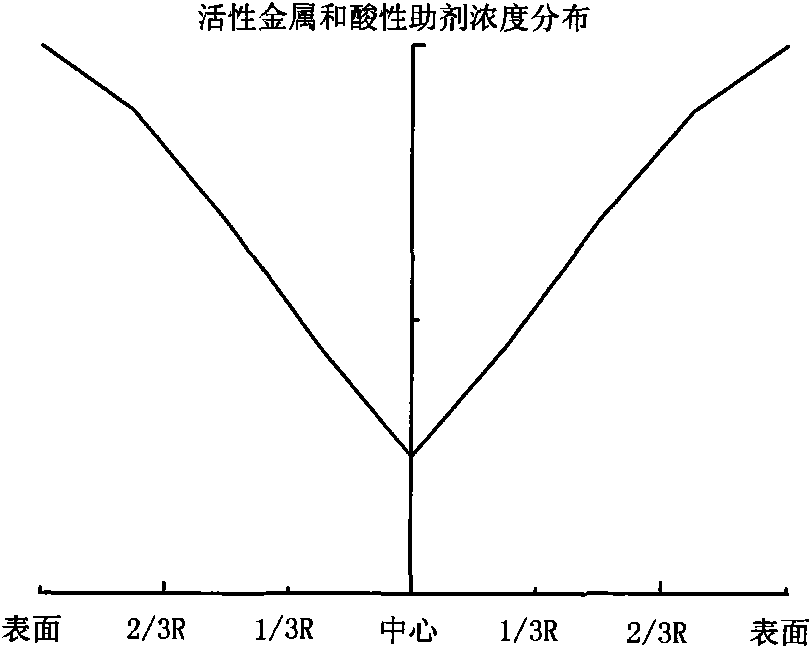Grading composition of hydrogenation catalyst
A hydrogenation catalyst and gradation combination technology, applied in refining to remove heteroatoms, etc., can solve the problems of large cold hydrogen demand, pore size limitation, poor hydrogenation saturation capacity of polycyclic aromatic hydrocarbons, etc., to extend the operation cycle and slow down Inactivation speed, effect of temperature rise control
- Summary
- Abstract
- Description
- Claims
- Application Information
AI Technical Summary
Problems solved by technology
Method used
Image
Examples
Embodiment 1
[0025] This example shows the preparation process of a catalyst gradation combination system. The catalyst gradation assembly scheme is adopted, the reactor is filled with catalyst, and the bed is filled with demetalizing agent and desulfurizing agent from top to top, and the adding ratios are 45% and 55%, respectively.
[0026] The preparation method of the metal removal catalyst is as follows:
[0027] Take Al 2 O 3 As a carrier, according to the stepwise and multiple impregnation method provided by European Patent 0204314, a catalyst with active metal components of Mo, Co and Ni is prepared. Take 500g Al 2 O 3 The carrier was immersed in 750 mL of Co-Ni hydrochloric acid solution with Co and Ni contents of 4.0% and 3.0% respectively at room temperature for 4 hours, and then immersed in deionized water for 30 minutes after being taken out. It was then dried at 120°C for 3 hours, and then calcined in air at 500°C for 2 hours. The prepared catalyst is then immersed in an aqueous ...
Embodiment 2
[0031] This example shows the preparation process of a catalyst gradation combination system. The catalyst gradation assembly scheme is adopted, the reactor is filled with catalyst, and the bed is filled with demetalizing agent and desulfurizing agent from top to top, and the addition ratios are 35% and 65%, respectively.
[0032] Demetallization catalyst with Al 2 O 3 As a carrier, according to the method provided by CN 1102448C, a catalyst with active metal components of Mo and Ni is prepared by the method of unsaturated spray immersion and low-temperature drying and air drying.
[0033] Weigh 150g of Al with a water absorption rate of 1.10mL / g 2 O 3 The carrier, according to the volume ratio of the immersion liquid volume to the saturated absorption solution volume, is 0.80, and spray dipping contains 18.6g ammonium molybdate (containing MoO 3 82m%), 17.10g nickel nitrate (containing 25.2m% NiO), 8g 85% phosphoric acid in 132mL. After homogenizing for 5 minutes in a spray dippi...
Embodiment 3
[0038] This example shows the preparation process of a catalyst gradation combination system. The catalyst gradation assembly scheme is adopted, the reactor is filled with catalyst, and the bed is filled with demetalizing agent and desulfurizing agent from top to top, and the addition ratios are 30% and 70%, respectively.
[0039] The demetalization catalyst is the same as in Example 1.
[0040] The preparation method of the desulfurization catalyst is as follows:
[0041] To contain 2.0m% ZrO 2 Al 2 O 3 As a carrier, a immersion method is used to prepare a catalyst with active metal components of Mo and Ni.
[0042] Weigh 150g water absorption rate 1.10mL / g containing 2.0m% ZrO 2 Al 2 O 3 The carrier, passed through water vapor for 1h, was taken out in 330mL containing 11.9g ammonium molybdate 3 82m%) and 10.5g nickel nitrate (containing 25.2m% NiO) and 2g 85% phosphoric acid in an aqueous solution soaked for 1 hour, then dried at 120°C for 3 hours, and then calcined in air at 500°C...
PUM
| Property | Measurement | Unit |
|---|---|---|
| Specific surface area | aaaaa | aaaaa |
| Average pore size | aaaaa | aaaaa |
| Specific surface area | aaaaa | aaaaa |
Abstract
Description
Claims
Application Information
 Login to View More
Login to View More - R&D
- Intellectual Property
- Life Sciences
- Materials
- Tech Scout
- Unparalleled Data Quality
- Higher Quality Content
- 60% Fewer Hallucinations
Browse by: Latest US Patents, China's latest patents, Technical Efficacy Thesaurus, Application Domain, Technology Topic, Popular Technical Reports.
© 2025 PatSnap. All rights reserved.Legal|Privacy policy|Modern Slavery Act Transparency Statement|Sitemap|About US| Contact US: help@patsnap.com



